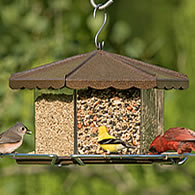
A feeder like the Triple Bin Feeder from Duncraft permits you to offer three different kinds of seeds or seed mixes at the same time, and you can even use it to test which birds prefer which seeds in your own yard.
|
The kinds of seeds you stock your feeders with dictate what birds are attracted to your feeders. Knowing this, birders focus their seed feeding on the specific birds they want to attract. But there are also birds that some birders prefer not to attract, so they don’t provide seeds that attract birds they don’t want to visit their feeders. The understanding of the give and take of attracting the birds you prefer with the food they relish, and withholding seeds that attract unwanted visitors all begins with reading the ingredient lists on seed packages.
Many birders concentrate on feeding a few kinds of seeds, primarily sunflower seeds, nyjer seeds, and peanuts. In short, black oil sunflower seeds probably provide the highest level of food value for most birds, followed by striped sunflower seeds. Shelled sunflower seeds are a best case option, because they do not make the mess that accumulates from discarded sunflower shells. Sunflower chips are similar, but are cut or “chipped” to make them smaller for smaller birds.
Some birds don’t relish sunflower seeds, such as many smaller finches, but prefer nyjer seeds, which are similar to the wild thistle seeds they prefer in the field. Nyjer and thistle seeds are mostly synonymous, although nyjer is the preferred wild bird feeding industry name today. They are said to have the most oil content of any seeds, in spite of their small size.
Peanuts are more of a seed than a nut, but either way they are preferred by some birds, such as jays, and appreciated by many birds. At the same time, any true nuts are legitimate bird foods for any birds that eat them, and they are nutritious too.
The best mixes have a combination of the above seeds, and maybe some of the secondary seeds, but many advanced birders avoid secondary seeds altogether. Overall, it’s a good idea to read the ingredient lists on the seed packages, inspect the seed mix through the packaging, and make sure you’re getting what you’re paying for – and what the birds you wish to attract prefer. Some lesser seeds are often over-emphasized in seed mixes, especially mixes you tend to buy at grocery stores. Opt to do your shopping at a wild bird store although if that’s not an option, some hardware stores and specialty stores offer quality bird seeds and seed mixes.
Shelled seed mixes devoid of secondary bird seeds have gained popularity and are considered preferred by many birders due to the reduced mess of shells. Ultimately, you pay only for seeds and not for shells and secondary filler seeds. You can make your own seed mixes too, but the bottom line is that you should feed the seeds preferred by the birds you want to attract and observe.
Primary Bird Seeds
Black oil sunflower seeds
Striped sunflower seeds
Sunflower chips
Nyjer seeds (“thistle”)
Peanuts
Secondary Bird Seeds
Safflower
Red milo
Millet
Cracked corn
Seed Mixes
Shelled seed mixes
Preferred seed mixes
“Grocery” mixes
Refer to this PDF file for a helpful table of common birds that visit feeders and the seeds they prefer at http://www.ectownusa.net/wbfi/docs/ProjWildbird_Research_2011_NA_numbers.pdf
The Wild Bird Feeding Industry provides some introductory information about bird seeds at https://www.wbfi.org/wild-bird-feed-product-basics.html
Share your backyard birding experiences and photos at editorstbw2@gmail.com